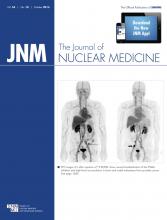PET and prostate cancer: Jadvar provides perspective on the current status of molecular imaging of prostate cancer with PET, including assessment of a range of radiotracers and prospects for future development.
Response criteria in PRRT: van Vliet and colleagues compare tumor response assessment using 4 common criteria in patients with neuroendocrine tumors treated with 177Lu-octreotate peptide receptor radionuclide therapy.
PET in breast cancer: Gemignani and colleagues describe correlation of 18F-FES PET with expression of estrogen and progesterone receptors in patients with primary, operable breast cancer.
Textural features in oropharyngeal cancer: Cheng and colleagues determine whether textural features in pretreatment 18F-FDG PET/CT can provide additional prognostic information over total lesion glycolysis and clinical staging in advanced oropharyngeal squamous cell carcinoma.
PET, ablative radiotherapy, and HCC: Huang and colleagues explore the utility of 18F-FDG PET and a combined 18F-FDG–contrast CT parameter for predicting tumor control in patients with hepatocellular carcinoma treated with stereotactic ablative radiotherapy.
99mTc-sestamibi and Gaucher disease: Erba and colleagues investigate the reliability of 99mTc-sestamibi scintigraphy in monitoring changes in bone marrow involvement induced by enzyme replacement therapy in patients with Gaucher disease.
PET and survival in osteosarcoma: Byun and colleagues explore the ability of metabolic and volumetric parameters on pretreatment 18F-FDG PET/CT as well as histologic and chemotherapeutic response to predict survival in patients with osteosarcoma of the extremities.
β-blockers and hemostasis in heart failure: de Peuter and colleagues use 123I-MIBG imaging to compare cardiac sympathetic activity with selective and nonselective β-blockers in patients with heart failure and correlate results with serum markers for coagulability.
PET and abdominal aortic aneurysms: Courtois and colleagues compare 18F-FDG uptake in aneurysmal wall biopsies from patients with abdominal aortic aneurysms to determine whether PET can identify cellular and molecular changes predictive of deterioration and rupture.
Regadenoson 82Rb cardiac PET: Hsiao and colleagues explore the diagnostic performance of regadenoson 82Rb myocardial perfusion PET imaging in detection of obstructive coronary artery disease in patients with and without pretest likelihood of cardiac disease.
68Ga-DOTATOC and 68Ga-DOTATATE dosimetry: Sandström and colleagues document the comparative biodistributions and radiation dosimetry of these radiolabeled somatostatin analogs for PET imaging in patients with neuroendocrine tumors.
Novel A2A receptor tracer: Tavares and colleagues describe the kinetic properties, test–retest results, and dosimetry estimates of a 123I-labeled SPECT tracer for in vivo imaging of adenosine 2A receptors in the brain.
Improved AC for PET/MR: Bezrukov and colleagues assess the accuracy of 4 MR-based attenuation correction techniques for hybrid PET/MR imaging in lesions within soft tissue, bone, and MR susceptibility artifacts.
Radionuclide imaging in epilepsy: Kumar and Chugani provide an educational overview of current applications of PET and SPECT in presurgical evaluation of intractable seizures, including localizing epileptogenic regions, identifying dual pathologies, assessing secondary foci, and evaluating brain functional integrity.
Alternative to mice in tracer development: Warnock and colleagues demonstrate PET and CT imaging in a U87 glioblastoma tumor model grown on chicken chorioallantoic membranes as a rapid, inexpensive, and ethically sustainable alternative to mice in novel PET tracer research.
PulmoBind lung imaging: Létourneau and colleagues detail the design of and early translational studies with a 99mTc-labeled adrenomedullin-based compound for molecular imaging of the pulmonary circulation.
99mTc GRPs in tumor imaging: Marsouvanidis and colleagues detail the development of a series of 99mTc-labeled demomedin C analogs and compare their performance in both in vitro and in vivo gastrin-releasing peptide receptor tumor models.
Metabolism of 11C-PD153035: Samén and colleagues investigate the in vivo metabolic characteristics of this analog of an epidermal growth factor receptor tyrosine kinase inhibitor to determine whether alterations in metabolite formation are accompanied by changes in biodistribution and tumor uptake.
PET-compatible tissue bioreactor: Whitehead and colleagues detail the development of a tissue bioreactor enabling modulation of the microenvironment and integration of the reactor with a small-animal PET scanner to facilitate imaging biomarker and radiopharmaceutical research.
Microfluidic radioassay: Wang and colleagues describe the development and use of a portable radiopharmaceutical imaging platform designed to capture the kinetics of cellular responses to drugs.
nanoScan PET/MR performance: Nagy and colleagues evaluate the standards-based performance of this high-resolution integrated system for consecutive PET and MR imaging of small laboratory animals.
Inveon SPECT capabilities: Boisson and colleagues assess the performance metrics of this small-animal system using 3 dedicated collimators for imaging in mice and 3 for rats.
Radioluminescence microscopy and 18F-FDG uptake: Pratx and colleague report on a particle-counting method for improving spatial resolution and overcoming β-range limits in fluorescence microscopy imaging of radionuclide uptake by single cells.
- © 2013 by the Society of Nuclear Medicine and Molecular Imaging, Inc.







